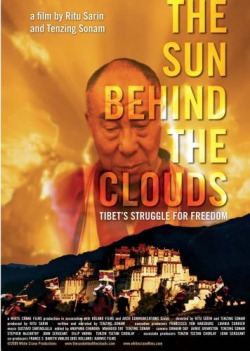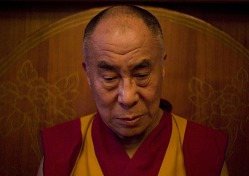Twailer Park Movies
The Sun Behind the Clouds

Release Date March 31, 2010
"Behind The Clouds" explores Tibetans' fifty-year struggle for independence, utilizing access to the Dalai Llama while examining the interplay between his approach of dialogue and compromise and a younger generation of Tibetans ready to take a more confrontational course. 2008, the year of the Beijing Olympics, saw the largest uprising of Tibetans against Chinese control since 1959. The Chinese government responded forcefully, precipitating unrest in the Tibetan exile community and inspiring a long march from India to the Tibetan homeland, amidst a groundswell of international sympathy.
Writer: Tenzing Sonam
Director: Ritu Sarin and Tenzing Sonam
"Behind The Clouds" explores Tibetans' fifty-year struggle for independence, utilizing access to the Dalai Llama while examining the interplay between his approach of dialogue and compromise and a younger generation of Tibetans ready to take a more confrontational course. 2008, the year of the Beijing Olympics, saw the largest uprising of Tibetans against Chinese control since 1959. The Chinese government responded forcefully, precipitating unrest in the Tibetan exile community and inspiring a long march from India to the Tibetan homeland, amidst a groundswell of international sympathy.
Writer: Tenzing Sonam
Director: Ritu Sarin and Tenzing Sonam
A Brief History of Tibet:
Tibet is a plateau region in Asia and a disputed territory, north of the Himalayas. It is home to the indigenous Tibetan people, and to some other ethnic groups such as Monpas and Lhobas, and is inhabited by considerable numbers of Han and Hui people. Tibet is the highest region on earth, with an average elevation of 4,900 metres (16,000 ft). It is sometimes referred to as the roof of the world.
During Tibet's history, it has existed as a region of separate sovereign areas, a single independent entity[2] and as a vassal under Chinese suzerainty or sovereignty. Tibet was first unified under King Songtsän Gampo in the 7th century. At various times from the 1640s until 1950s, a government nominally headed by the Dalai Lamas, a line of spiritual political leaders, ruled a large portion of the Tibetan region. During some of this period, the Tibetan administration was subordinate to the Chinese empire of the Qing Dynasty.
In 1913 the 13th Dalai Lama expelled Qing's representatives and troops from what is now the Tibet Autonomous Region. While the expulsion was seen as an assertion of Tibetan autonomy, Tibet's proclaimed independence was not accepted by the government of China, nor did Tibet receive foreign diplomatic recognition and in 1945 China's sovereignty over Tibet was not questioned by the United Nations.
Following a decisive invasion and battle at Chamdo in 1950, the Communist Party of China gained control of the region of Kham to the West of the Upper Yangtze River. The next year the 14th Dalai Lama and his government signed the Seventeen Point Agreement. In 1959, he together with a group of Tibetan leaders and followers fled to India and set up the Government of Tibet in Exile in Dharamshala. Beijing and the Government-in-exile disagree over when Tibet became a part of China, and whether the incorporation into China of Tibet is legitimate according to international law. Since what constitutes Tibet is a matter of much debate (see map, right), neither its size nor population are simple matters of fact, due to various entities claiming differing areas as part of "Tibet".
Tibet is a plateau region in Asia and a disputed territory, north of the Himalayas. It is home to the indigenous Tibetan people, and to some other ethnic groups such as Monpas and Lhobas, and is inhabited by considerable numbers of Han and Hui people. Tibet is the highest region on earth, with an average elevation of 4,900 metres (16,000 ft). It is sometimes referred to as the roof of the world.
During Tibet's history, it has existed as a region of separate sovereign areas, a single independent entity[2] and as a vassal under Chinese suzerainty or sovereignty. Tibet was first unified under King Songtsän Gampo in the 7th century. At various times from the 1640s until 1950s, a government nominally headed by the Dalai Lamas, a line of spiritual political leaders, ruled a large portion of the Tibetan region. During some of this period, the Tibetan administration was subordinate to the Chinese empire of the Qing Dynasty.
In 1913 the 13th Dalai Lama expelled Qing's representatives and troops from what is now the Tibet Autonomous Region. While the expulsion was seen as an assertion of Tibetan autonomy, Tibet's proclaimed independence was not accepted by the government of China, nor did Tibet receive foreign diplomatic recognition and in 1945 China's sovereignty over Tibet was not questioned by the United Nations.
Following a decisive invasion and battle at Chamdo in 1950, the Communist Party of China gained control of the region of Kham to the West of the Upper Yangtze River. The next year the 14th Dalai Lama and his government signed the Seventeen Point Agreement. In 1959, he together with a group of Tibetan leaders and followers fled to India and set up the Government of Tibet in Exile in Dharamshala. Beijing and the Government-in-exile disagree over when Tibet became a part of China, and whether the incorporation into China of Tibet is legitimate according to international law. Since what constitutes Tibet is a matter of much debate (see map, right), neither its size nor population are simple matters of fact, due to various entities claiming differing areas as part of "Tibet".


